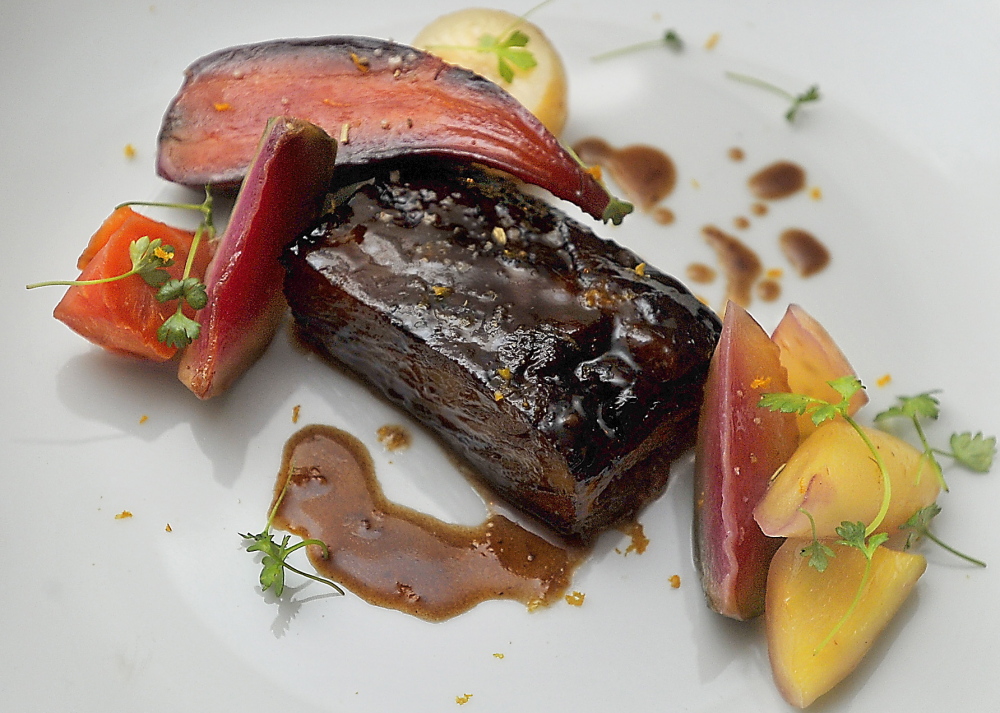Everyone knows Little Miss Muffet took hers with curds. But outside of Mother Goose rhymes, most eaters who knowingly consume whey today – the liquid byproduct of the cheesemaking process – take it in the form of protein bars and smoothies.
If you make your own cheese, though, you’ll find that for every gallon of milk you use you get one quart of cheese curds (the first step to cheese) plus three quarts of whey. The cheese you know what to do with, but is there a use for all that whey? In a word, yes. Many uses.
Chef Ilma Jeil Lopez, who owns Piccolo in Portland with her husband, chef Damien Sansonetti, is keen on using every drop of the silky, pleasingly sour whey left from making whole-milk ricotta cheese to use in the restaurant’s handmade pasta dishes. “No waste in this kitchen,” Lopez says.
Lopez and Sansonetti pan-steam potatoes and turnips in whey until they are tender (recipe below) and then fry them. The whey – which has a flavor like that of plain yogurt – adds flavor, while the protein absorbed by the vegetables during steaming turns them especially crispy when fried.
At Vinland, also in Portland, chef David Levi sometimes serves whey-poached parsnips. Also, in keeping with his local foods-only mantra, Levi uses whey to replace (non-local) citrus, for instance, adding brightness to spicy, garlicky mussels when he cooks them with whey.
You can also simply drink it: straight; mixed with lemon juice and a sweetener to make probiotic lemonade; or in a boozy cocktail like the Pine Gimlet at Vinland, where it shares the glass with gin and pine syrup.
In baking, whey can replace water in most bread recipes and buttermilk in most cake recipes. Barrington, New Hampshire, homesteader Steve Diamond uses whey to make pancakes. The considerable reaction between the acids in the whey and the baking powder in the batter provides enough leavening power that he can use straight whole-wheat flour and still get light and fluffy pancakes.
If you’re not making your own cheese, ask a local cheese maker to set aside whey for you, Maine Cheese Guild President Eric Rector suggests. “It is not in short supply,” he said, “but by necessity, all cheese makers have developed ways to handle the whey we inevitably produce.”
Buy an extra quart – it keeps in the refrigerator for up to six days, and freezes really well, too.
WHEY-BRAISED POTATOES AND TURNIPS
A batch of Piccolo’s house-made ricotta yields 6 quarts of whey. At the restaurant, chef/owners Ilma Jeil Lopez and Damien Sansonetti use that whey to pan-steam all sorts of vegetables. They often use separate pans to preserve the vegetables’ color; we’ve simplified the procedure for the home cook.
Serves 4 to 6 as a side dish.
1 pound medium red potatoes
1 pound small turnips
2 cups whey
Canola oil
Salt and pepper
2 tablespoons chopped parsley
Cut the potatoes into quarters. Trim the tops and root ends of the turnips and cut into quarters.
Place the potatoes and turnips in a single layer in a large sauté pan. Add whey. Cover the pan and place over medium high heat. Pan-steam the vegetables until just tender and still fully intact, 10 to 12 minutes. Drain off and discard any whey that has not been absorbed. Set the vegetables aside.
Wipe the sauté pan clean. Place it over high heat and apply a thin coat of oil to the pan. When the pan is very hot, add the cooked potatoes and turnips, tossing to coat them with oil. Cook the vegetables undisturbed until the undersides are crispy and slightly browned, 4 to 6 minutes. Season with salt and pepper. Garnish with parsley and serve warm.
Christine Burns Rudalevige is a food writer, recipe developer and tester, and cooking teacher in Brunswick. She writes about feeding her family Maine seafood at www.familyfish.net. Contact her at cburns1227@gmail.com.
Send questions/comments to the editors.



Comments are no longer available on this story